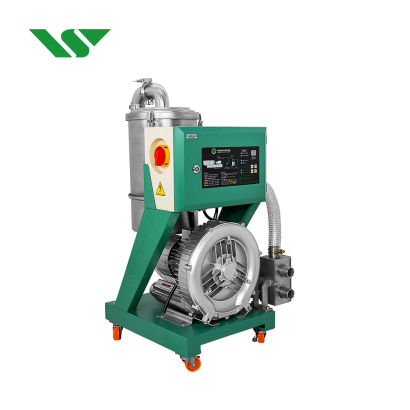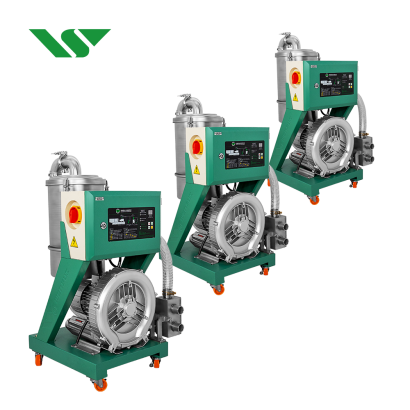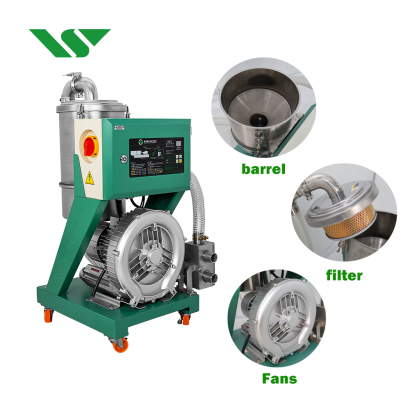Choosing the Right Feeding Systems Solution for Injection Molding Efficiency
2024-11-11 Page view:
As industries seek to improve efficiency, the feeding systems for injection molding machines are evolving. Manufacturers now have options between centralized and single-machine feeding systems, each offering unique benefits and challenges. Choosing the right approach can optimize production, reduce costs, and improve the working environment. This article will explore the pros and cons of centralized and single-machine feeding systems to help manufacturers make informed decisions.

Understanding Centralized Feeding Systems for Injection Molding
A centralized feeding system involves a main control unit that supplies raw materials to multiple injection molding machines simultaneously. This setup automates the feeding process and allows for the central storage of raw materials, reducing the need for on-site handling. By centralizing control, manufacturers can save on labor costs, reduce floor space requirements, and improve material flow efficiency. Additionally, centralized feeding helps maintain a cleaner, organized production environment by moving raw material handling and dust collection away from the machines themselves.
Examining Single-Machine Feeding Systems: Key Features and Benefits
In a single-machine feeding system, each injection molding machine has its dedicated feeder and control unit. This independent setup is particularly beneficial for operations that require more flexibility, as each machine operates autonomously. If one machine requires maintenance or downtime, other machines remain unaffected. For smaller-scale production or settings where different materials are used frequently, single-machine feeding offers the adaptability needed for efficient operation. Additionally, single-machine setups are easier to manage individually and can reduce initial setup costs compared to centralized systems.
Cost Efficiency: Which System Saves More in the Long Run?
Cost considerations are critical in deciding between centralized and single-machine feeding systems. Centralized systems have a higher initial cost due to the need for a central control unit and infrastructure to connect multiple machines. However, over time, centralized systems are more energy-efficient as one vacuum pump can often handle several machines, reducing power consumption. Single-machine feeding systems, while initially less expensive, require individual pumps for each machine, leading to higher energy use in high-volume production settings.

Maintenance and Downtime: Comparing Repair Needs and Impact on Production
Maintenance is another important factor. Centralized feeding systems are designed for efficiency and can be equipped with backup units to prevent downtime during repairs. In single-machine setups, maintenance can be performed on one machine without affecting others, which adds flexibility. However, single machines often have more wearing parts, increasing maintenance needs and potentially raising costs over time. In centralized systems, downtime for one pump may impact multiple machines, but with proper backup systems in place, these risks can be minimized.
Environmental and Space Considerations: Creating a Cleaner Production Environment
Centralized feeding systems offer clear environmental advantages by centralizing raw materials and dust collection away from production areas. This setup improves the cleanliness of the workspace, reduces clutter around machines, and minimizes contamination risks. Conversely, single-machine feeding requires raw materials to be placed near each machine, which can increase dust and clutter, potentially affecting product quality and overall working conditions. For manufacturers aiming to maintain a cleaner and more organized workshop, centralized systems offer a compelling advantage.

Energy Use and Automation: Finding the Best Solution for Long-Term Efficiency
Energy efficiency is another critical factor. Centralized systems, with their ability to supply multiple machines through one vacuum pump, tend to consume less energy in high-production environments. They also integrate automation features that enable centralized monitoring and remote operation, reducing human intervention and operational costs. Single-machine systems, however, consume more power as each unit requires its own pump. For companies looking to save on energy costs and streamline operations, a centralized system is typically more advantageous, though single machines may be better suited for smaller operations.
Choosing between centralized and single-machine feeding systems depends on production scale, flexibility needs, budget, and workspace requirements. Centralized systems excel in high-volume production environments, offering greater automation, energy savings, and a cleaner work environment. In contrast, single-machine feeding systems provide flexibility, lower initial costs, and ease of maintenance for smaller or varied production needs. By assessing these factors, manufacturers can choose a feeding system that aligns best with their production goals and operational needs.



